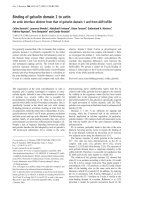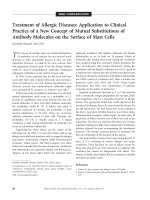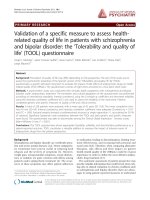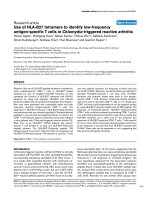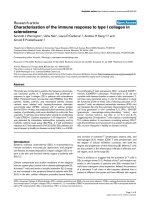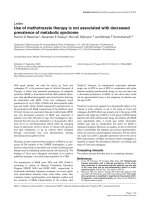Báo cáo y học: "Use of taste-masking product, FLAVORx, to assist Thai children to ingest generic antiretrovirals" pdf
Bạn đang xem bản rút gọn của tài liệu. Xem và tải ngay bản đầy đủ của tài liệu tại đây (217.01 KB, 5 trang )
BioMed Central
Page 1 of 5
(page number not for citation purposes)
AIDS Research and Therapy
Open Access
Short report
Use of taste-masking product, FLAVORx, to assist Thai children to
ingest generic antiretrovirals
Torsak Bunupuradah*
1
, Siripan Wannachai
1
, Arpa Chuamchaitrakool
1
,
Jintana Intasan
1
, Thantip Nuchapong
1
, Woodie Neiss
2
, Kenny Kramm
2
,
Chitsanu Pancharoen
3
, David Burger
4
and Jintanat Ananworanich
1
Address:
1
The HIV Netherlands Australia Thailand Research Collaboration (HIV-NAT), Bangkok, Thailand,
2
FLAVORx company, Bethesda, USA,
3
Chulalongkorn University, Bangkok, Thailand and
4
UMC St Radboud, Nijmegen, The Netherlands
Email: Torsak Bunupuradah* - ; Siripan Wannachai - ; Arpa Chuamchaitrakool - ;
Jintana Intasan - ; Thantip Nuchapong - ; Woodie Neiss - ;
Kenny Kramm - ; Chitsanu Pancharoen - ; David Burger - ;
Jintanat Ananworanich -
* Corresponding author
Abstract
We evaluated whether FLAVORx helped thirty Thai children take opened capsule, crushed tablets
and liquid generic ARVs with more ease. All children had excellent adherence, evaluated by PACTG
Standard International Questionnaire and interviewing, before and after one month of FLAVORx.
Eighty percent took ARV with more ease and wish to continue FLAVORx. Strawberry was the
most popular flavor.
Background
Most children with HIV infection live in resource-limited
settings. With the recent availability of generic antiretrovi-
rals (ARV), more children are being treated. The Thai Gov-
ernment Pharmaceutical Organization (GPO) began
producing generic ARVs in 2001. Out of about fifty thou-
sand children living with HIV in Thailand, five thousand
children are now on ARVs [1]. However, the formulations
of ARVs produced by the GPO are mainly solid dosage
forms for adults with only a few liquid dosage forms suit-
able for children. In addition, the Access to Care Program
by the Thai Government provides mainly pill formula-
tion. Children under seven years of age are usually unable
to swallow pills, capsules or tablets. The HIV Netherlands
Australia Thailand Research Collaboration (HIV-NAT),
Thai Red Cross AIDS Research Centre, has over one hun-
dred fifty children on ARVs, many of these children have
to take opened capsule, crushed tablets or large amounts
of liquid ARVs. Inappropriate formulations and bad taste
have been reported to lead to poor adherence in children
[2] which can in turn cause treatment failure [3-6]. We
think that it is important to explore ways to make it easier
for our children to take ARVs since these are long term
chronic medications that children with HIV must take to
survive; anything that can be done to make their circum-
stances easier, live happier is a virtue.
FLAVORx flavors are FDA, TGA (Australian Regulatory
Agency – Therapeutic Goods Administration), HAS
(Health Services Australia
) and Health Canada approved.
When FLAVORx was added in the proper formulations
they mask the bad, bitter or acrid tastes of medications.
FLAVORx has been used in the United States, Canada,
Australia and New Zealand to make medicine including
Published: 29 December 2006
AIDS Research and Therapy 2006, 3:30 doi:10.1186/1742-6405-3-30
Received: 03 August 2006
Accepted: 29 December 2006
This article is available from: />© 2006 Bunupuradah et al; licensee BioMed Central Ltd.
This is an Open Access article distributed under the terms of the Creative Commons Attribution License ( />),
which permits unrestricted use, distribution, and reproduction in any medium, provided the original work is properly cited.
AIDS Research and Therapy 2006, 3:30 />Page 2 of 5
(page number not for citation purposes)
ARVs more palatable. FLAVORx is a non allergenic, sugar-
free inert product [see more information in additional file
1, 2] that does not interfere with drug levels. Over forty
million prescriptions were filled so far with FLAVORx,
without any interactions reported. (Personnel communi-
cation: Kenny Kramm, President, CEO of FLAVORx com-
pany). Impact of FLAVORx on pediatric inpatients
admitted to a Children's hospital has been evaluated as
reported earlier [7,8]. In this study, we evaluated whether
FLAVORx, a taste masking blend, helped thirty Thai chil-
dren take opened capsule, crushed tablet and liquid
generic ARVs with more ease.
Patients and methods
From September to November 2005, caregivers of chil-
dren with HIV infection whom were part of our prospec-
tive cohort study and taking opened capsule, crushed
tablets or liquid ARVs were asked if they were interested in
having their children use a taste-masking product. The
first thirty children whom caregivers agreed were
recruited. All caregivers understood the study and signed
the informed consent form. The study protocol, HIV-NAT
015, opened label, one arm, cohort study, was approved
by the Chulalongkorn Institutional Review Board.
Before the start of the study, ten flavors (strawberry,
orange, banana, grapes, bubble gum, water melon,
lemon, cherry, vanilla, chocolate) were mixed with the
following generic ARVs, products of Thai GPO, by
research staffs at The FLAVORx Research Institute and
taste to find the best flavors for taste masking: Stavudine
or d4T (Stavir
®
, GPO) opened capsule, Zidovudine or AZT
(Antivir
®
, GPO) opened capsule and liquid, Didanosine
or ddI (Divir
®
, GPO) powder, Nevirapine or NVP (Nera-
vir
®
, GPO) crushed tablet, Lamivudine or 3TC (Lamivir
®
,
GPO) crushed tablet and liquid, or Efavirenz or EFV (Sto-
crin
®
, Merck) opened capsule and Indinavir or IDV (Crix-
ivan
®
, Merck) opened capsule supported by the National
Access to Antiretroviral Program for People living with
HIV/AIDS (NAPHA), were also tested. There were ten
available flavors. The best flavors were then mixed with
each ARV, tasted and scored by at least two Thai physi-
cians and six nurses to determine the most likely popular
flavors to Asians' palate. The best three flavors for each
ARV were then offered to the children in the study before
the other flavors were offered in order to limit the number
of flavors children have to taste.
Children were followed twice, one month apart. At each
visit, the caregivers were asked to complete the approved
Thai version of the NIAID Pediatric AIDS Clinical Trial
Group (PACTG) Standard International Questionnaire
[9]. The caregivers were also interviewed using open
ended questions about the child's adherence and diffi-
culty in taking ARV, the caregiver's technique of giving
ARV to the child and their attitude towards using a taste-
masking product. At the first visit, children were encour-
aged to taste the different flavors and choose up to three
flavors themselves. They can use different selected flavors
with each of their medications. The study nurse instructed
the caregiver on mixing procedure which were different
for each child depending on the formulation and dosing
of ARV. For example, one to three drops of FLAVORx plus
four drops of a sweetening agent were used to mix one
crushed tablet or one opened capsule in five ml of water.
For the first ten children whom caregivers agreed, trough
levels of NNRTI or PI were performed at both visits. Sam-
ples were drawn just prior to the next dose for trough lev-
els of NNRTI or PI at both visits. After using FLAVORx for
three days, the study nurse called the caregivers to confirm
the method of mixing FLAVORx.
Statistic analysis
Statistical analysis was performed with SPSS version 12.0
(SPSS, Chicago).
Results
Thirty children were included. The characteristics are
shown in Table 1. Mean age was 5.2 ± SD 1.9 years with
forty percent boys. Most had mild or moderate HIV symp-
toms, CDC category [10] A: B: C was 10:12:8. The median
CD4 was 25% (IQR 17–30). Mean weight was 16.2 ± 4.1
kilograms. Mean height was 102.8 ± 10.9 centimeters. All
children were using generic NRTIs; most combining with
generic NVP, branded EFV or Kaletra. The caretakers were
fourteen mothers, five fathers, six grandmothers and five
aunts.
At the first visit, all thirty caregivers answered that the
child had never missed any ARV dose and that they did
not experience problems with giving the child the ARV on
time everyday. However, during the interview, most car-
egivers reported that the child disliked taking ARVs
because of the bitter taste especially generic AZT syrup,
3TC syrup, ddI powder, NVP crushed tablet and EFV
opened capsule. The techniques caregivers used varied
from using alarm clock, having the child drink fruit juice
immediately after the dose, mixing ARV with syrup, honey
or food, forcing the child to take ARV and bribe the child
with treats. The flavors chosen at the first visit were straw-
berry, orange and grape in twenty three, fifteen and four
children respectively.
At the final visit, caregivers gave the same answers for the
PACTG adherence questionnaire with no reported prob-
lems or occurrence of poor adherence. From the interview,
twenty four caregivers reported that, after using FLAVORx,
their children had an easier time taking ARV FLAVORx. All
of them reported that their children liked the nice flavor
of FLAVORx and seven of twenty four children said the
AIDS Research and Therapy 2006, 3:30 />Page 3 of 5
(page number not for citation purposes)
Table 1: Demographic Data and Results
No. gender Age (y) Wt (Kg) Ht (cm) CDC CD4% (cell/mm
3
) Regimen* Chosen flavors NNRTI Trough level **(mg/L) Reason of discontinue FLAVORx
VisitI VisitII VisitI VisitII
1 F 6.7 16 112.5 B 13%(277) AZT 1cap+7 mlX2 3TC 1/2 tabX2 NVP 3/4 tabX2 S x 3.94 4.19 Spicy taste
2 M 5.5 17 111 B 39%(1108) AZT 1 cap +6 mlX2 3TC 7 mlX2 NVP 3/4 tabX2 S, O x 14.80 7.01 Child prefer to mix ARV with water
3 F 3.5 12.5 92.5 A 7%(342) 3TC 5 mlX2 EFV 200 mg d4T 1/3 tabx2 O x 11.88 8.29 Spicy taste
4 F 4.2 14 97 A 10%(210) AZT 1 cap +5 mlx2 3TC 6 mlx2 EFV 200 mg S S 2.14 1.55
5 M 4.8 17.2 106 A 24%(1122) AZT1 cap +7 mlX2 3TC 1 tab X2 NVP 3/4 tabX2 S, O S,G 5.66 5.60
6 M 5.3 12.5 93 B 6%(459) AZT 1 cap +4 mlX2 3TC 5 mlx2 NVP 1/2 tabx2 S S 3.05 3.45
7 F 4.5 14 99 C 17%(356) AZT 1 cap +5 mlX2 ddI(170 mg) 1 × 1 S,O,G G - -
8 M 4 15 96 A 42%(2278) AZT 1 cap +5 ml 3TC 6 mlx2 EFV 200 mg S x 1.93 2.45 Vomiting
9 F 7.5 29.6 126 A 29%(614) AZT 2 cap X2 3TC 1 tab X2 EFV 350 mg S x - - Child prefer to mix ARV with water
10 M 4.1 15 99 C 22%(945) AZT1 cap +5 mlX2 3TC 7 mlX2 EFV 250 mg S,O S 3.18 0.00 Repeat ***
11 F 4.6 23 106 A 25%(1224) 3TC 1 tab x2 EFV 300 mg ddI(115) 2 × 1 S S 1.40 3.78
12 M 1 11.5 84.5 C 38%(1732) 3TC 4 mlx2 NVP 1/2 tab X2 d4T 10 mgx2 O S,G,B 3.51 4.30
13 F 4.8 14.1 97 A 35%(1428) AZT 1 cap +5 mlX2 3TC 1 tabX2 EFV 250 mg S S,B
14 F 2 10.2 83 B 24%(761) AZT 1 cap +2 ml × 2 3TC 5 ml × 2 Kaletra 1.4 ml × 2 O S
15 F 4.7 11.6 93 B 15%(250) 3TC 6 mlX2 NVP 1/2 tabX2 d4T 15 mgx2 S S
16 M 4 13.9 95.5 C 24%(960) AZT 1 cap +4 mlx2 3TC 6 mlx2 EFV 200 mg S S
17 F 5.5 14 104 B 22%(591) AZT 1 cap +4 mlX2 3TC 1/2 tab x2 NVP 3/4 tabx2 S S
18 M 4.3 15.1 103 C 26%(1261) AZT 1 cap +5 mlX2 3TC 7 mlX2 EFV 200 mg S S
19 M 7.7 17.5 105 B 23%(915) 3TC 1/2 tabX2 EFV 250 mg d4T 15 mgX2 O,G G
20 F 5.4 20 105.5 B 41%(1137) AZT 1 cap +5 mlX2 3TC 1tabX2 EFV 250 mg S,O B,A
21 F 9.8 18 119 B 27%(1086) AZT 1 cap +8 mlX2 3TC 1 tabX2 EFV 300 mg O,G G
22 F 8.8 18 116.5 B 6%(112) AZT 1 cap +8 mlX2 3TC 1/2 tabX2 NVP 3/4 tabX2 S G
23 F 1.8 10 82 A 33%(1933) AZT 1 cap +1 mlx2 3TC 5 mlX2 Kaletra 1.4 ml × 2 S,O O
24 M 8 22.6 119 B 25%(809) 3TC 1 tabX2 d4T 1/2 tabx2 NVP 3/4 tab x2 S,O x Child prefer to mix ARV with water
25 F 4 15.2 94 B 28%(817) 3TC 1/2 tabX2 EFV 200 mg d4T 15 mg S,B S,B
26 F 6.3 16.9 109 C 26%(723) AZT 1 cap +5 mlX2 3TC 1/2 tabX2 NVP 3/4 tabX2 O O
27 F 6.7 18.3 110 C 40%(1109) 3TC 7 mlX2 EFV 250 mg d4T 15 mg S,O B
28 M 4.5 15 102.5 A 28%(1076) 3TC 1/2 tabX2 EFV 200 mg d4T 15 mgX2 G G
29 F 6 19.2 110 A 12%(551) AZT 1 cap +8 mlX2 3TC 1/2 tab X2 NVP 3/4 tabX2 S,O G
30 M 5.7 20 114 C 17%(345) AZT 1 cap +8 mlX2 3TC 1 tabX2 EFV 300 mg S S
* The bolded drugs were mixed with FLAVORx
** compare to NNRTI target serum level: for NVP is 3.4 mg/l, EFV is 1.0 mg/l (Ref: John G. Bartlett, John Hopkins University School of Medicine, Pocket Guide to adult HIV/AIDS treatment, Jan 2005.
*** Repeat trough level without using FLAVORx = 3.74 mg/l
Chosen Taste: S = strawberry, O = orange, G = grape, B = banana, A = apple, X = children or parent did not want to continue FLAVORx
Cap = capsule, tab = tablet
AIDS Research and Therapy 2006, 3:30 />Page 4 of 5
(page number not for citation purposes)
medications tasted sweeter. Twenty-four of thirty (eighty
percent) children said that they liked FLAVORx and
wanted to continue using it. Fifteen children (fifty per-
cent) chose to use the same flavor; strawberry (thirteen),
orange (two), grapes (four), banana (one), and nine
wanted to try new flavors; strawberry (six), orange (ten).
Six children who didn't want to continue using FLAVORx;
caregivers of three children found it too difficult, two chil-
dren (on orange and strawberry flavors) reported burning
sensation on the tongue, and one child had repeated vom-
iting immediately after taking FLAVORx (strawberry fla-
vor).
Therapeutic drug monitoring in the first ten children
showed trough levels above the target serum levels [11] at
the first and final visits in all except one boy who had
undetectable level at the final visit. This boy was taking
EFV with strawberry and orange flavors. The mother
reported excellent adherence and more ease of taking ARV
after using FLAVORx. Repeat trough level in this child was
3.74 mg/l; however, he was not taking FLAVORx at that
time.
Discussion
In eighty percent of children participants, FLAVORx
helped them take ARVs with more ease by masking the
bitter taste of ARV. Strawberry, orange and Grape flavors
were the most popular. FLAVORx did not affect adherence
as full adherence was reported in all children despite the
problem of bitter ARV. In other parts of the world, chil-
dren may not be as willing to take bitter ARV. FLAVORx
did not affect ARV trough levels in nine of ten children.
The using of taste masking products has been shown to
help children take medications. Robert Wood Johnson
Children's Hospital in New Jersey found improvement in
hospitalized children's willingness to take medications
[7,8]. In the United States, the most popular flavor is bub-
ble gum. This was not selected by any of our patients. Pal-
atable tastes are probably affected by the typical food
flavors in each country. This is the first study of FLAVORx
in Asian children. It is likely that children from other
Asian countries would prefer the same flavors as our chil-
dren.
After using FLAVORx, most caregivers reported that their
children were happier during medication taking time
which fulfilled our goal for performing this study. A few
caregivers found the mixing procedure too difficult.
Therefore, this product may not be ideal to use in children
of caregivers who are unable to follow mixing procedures.
Although we cannot be certain, we suspect that the child
with undetectable efavirenz level at the final visit did not
take his medication. As an inert product, FLAVORx should
not effect on drug levels and it did not in nine of ten chil-
dren. Any interaction would have also unlikely to cause an
undetectable level.
There were two children (on orange and strawberry fla-
vors) felt a burning sensation on the tongue, which may
be due to excess use of flavoring agent or used wrong com-
bination of flavors for that child's sense of taste. There was
one child had repeated vomiting immediately after taking
FLAVORx (strawberry flavor) which could be due to the
child's sense of taste did not agree with this flavor choice
or the flavoring needed to be adjusted or the child had a
concomitant illness. After the study, we found that at
times some children went back to using the marketed
highly concentrated sugar syrup called Hale's Blueboy to
sweeten the medications. This is much sweeter than FLA-
VORx but the high sugar content is not good for their den-
tal health.
In summary, masking the taste of ARV by using FLAVORx
helped Thai children take ARV with more ease. This may
be explored in other countries especially where adult ARV
formulations are used in children.
Additional material
Acknowledgements
We thank Dr. Suchat Watnasirichaikul for his advice in mixing FLAVORx
with generic ARV. We are grateful to the PACTG for allowing us to use
their adherence questionnaire. We thank The Clinton Foundation for sug-
gesting that we explore the flavoring of ARVs for Asian children and for ini-
tiating contacts between HIV-NAT and FLAVORx. FLAVORx Company
covered the cost of this study and provided long-term FLAVORx to the
children in the study.
Additional file 1
Product specific sheet code number 710-381. FLAVORx Strawberry
Cream Flavor. Flavoring nomenclature: N&A Strawberry Cream Flavor.
Non-Flavoring Ingredients: Propylene Glycol, Ethyl Alcohol, Water,
Triacetin. No allergen, pH: N/A, colorless to pale red, water solubility, no
alcohol range by volume, recommended storage 7.2- 26.7°C, absent col-
iform count.
Click here for file
[ />6405-3-30-S1.pdf]
Additional file 2
Product specific sheet code number 711-218. FLAVORx Orange Cream-
sicle Flavor. Flavoring nomenclature: N&A Orange Creamsicle Type Fla-
vor. Non-Flavoring Ingredients: Propylene Glycol, Ethyl Alcohol. No
allergen, pH: N/A, yellow-green color, water solubility, no alcohol range
by volume, recommended storage 7.2- 26.7°C, absent coliform count.
Click here for file
[ />6405-3-30-S2.pdf]
Publish with BioMed Central and every
scientist can read your work free of charge
"BioMed Central will be the most significant development for
disseminating the results of biomedical researc h in our lifetime."
Sir Paul Nurse, Cancer Research UK
Your research papers will be:
available free of charge to the entire biomedical community
peer reviewed and published immediately upon acceptance
cited in PubMed and archived on PubMed Central
yours — you keep the copyright
Submit your manuscript here:
/>BioMedcentral
AIDS Research and Therapy 2006, 3:30 />Page 5 of 5
(page number not for citation purposes)
References
1. National ARV for people living with HIV AIDS (NAPHA project):
Bureau of AIDS, TB and STI, Department of disease control,
MOPH, Thailand 2006. [
]. Accessed
13 December 2006.
2. Guideline for the use of antiretroviral agents in pediatric
HIV infection March 24, 2005 AIDSinfo 2005 [http://aid
sinfo.nih.gov/]. Accessed 19 December 2005.
3. Watson DC, Farley JJ: Efficacy of and adherence to highly active
antiretroviral therapy in children infected with human
immunodeficiency virus type 1. Pediatr Infect Dis J 1999,
18:682-9.
4. Van dyke RB, Lee S, Johnson GM, et al.: Reported adherence as a
determinant of response to highly active antiretroviral ther-
apy in children who have human immunodeficiency virus
infection. Peadiatrics 2002, 109:e61.
5. Tuboi SH, Harrison LH, Sprinz E, Albernaz RK, Schechter M: Predic-
tors of Virologic Failure in HIV-1-Infected Patients Starting
Highly Active Antiretroviral Therapy in Porto Alegre, Bra-
zil. J Acquir Immune Defic Syndr 2005, 140:324-328.
6. Maggiolo F, Ravasio L, Ripamonti D, et al.: Similar adherence rates
favor different virologic outcomes for patients treated with
nonnucleoside analogues or protease inhibitors. Clin Infect Dis
2005, 1(40):158-63. Epub 2004 Dec 6.
7. Christine Jaderlund: The impact of a commercially available
medication flavoring system (FLAVORx
©
) on pediatric inpa-
tients admitted to a children's Hospital. Poster presentation:
14th Pediatric Pharmacy Conference: PPAG Annual Meeting, Chicago, USA
. October 9–12, 2005.
8. Christine Jaderlund: The impact of a commercially available
medication flavoring system (FLAVORx
©
) on pediatric inpa-
tients admitted to a children's Hospital. J Pediatr Pharmacol Ther
2005, 10(2):124-5.
9. NIAID PEDIATRIC AIDS CLINICAL TRIALS GROUP
(PACTG) PEDIATRIC INTERNATIONAL ADHERENCE
QUESTIONNAIRE Behavior/Identification QL5030 (P0000)/
00-00-00. PEDIATRIC AIDS CLINICAL TRIALS GROUP
2005 [ />]. Accessed 19
December 2005.
10. Revised Human Immunodeficiency Virus Pediatric Classification Sys-
tem: Clinical Categories, Centers for Disease Control and
Prevention.1994 Revised classification system for human
immunodeficiency virus infection in children less than 13
years of age. MMWR 1994, 43(RR-12):1-10.
11. John G: Bartlett, Drug table 2. Antiretroviral agents, Target
Serum Levels and CSF: Plasma ratio. John Hopkins University
School of Medicine, Pocket Guide to adult HIV/AIDS treatment, Jan 2005 .

